- Share
Is Debt Overhang Causing Firms to Underinvest?
Many economists have suggested that the weakness of corporate balance sheets is constraining business spending and investment, and that this in turn is impeding growth and the recovery. High levels of debt can depress spending and investment through several channels. This Commentary explains one of them—debt overhang can cause firms to underinvest—and points to ways in which this effect might be inhibiting the recovery.
The views authors express in Economic Commentary are theirs and not necessarily those of the Federal Reserve Bank of Cleveland or the Board of Governors of the Federal Reserve System. The series editor is Tasia Hane. This paper and its data are subject to revision; please visit clevelandfed.org for updates.
Many economists have suggested that the weakness of corporate balance sheets is constraining business spending and investment, and that this in turn is impeding growth and the recovery. High levels of debt can depress spending and investment through several channels. This Commentary explains one of them—debt overhang can cause firms to underinvest—and points to ways in which this effect might be inhibiting the recovery.
During the economic expansion that preceded the recent financial crisis, firms financed the growth of their balance sheets largely by borrowing, which led to a substantial increase in the level of their debt. When asset prices and valuations fell suddenly during the crisis, the leverage ratios of these firms deteriorated as a result. One measure of corporate leverage, the ratio of firms’ credit market debt to assets, recently reached a new historical high (see figures 1 and 2).
Figure 1. Assets and Debt
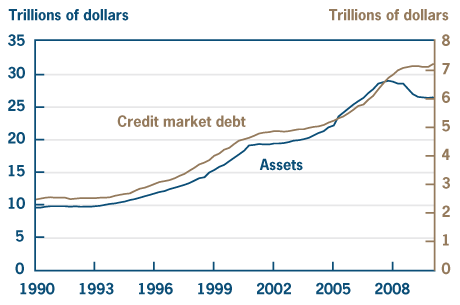
Note: Refers to the nonfarm nonfinancial corporate business sector.
Source: Federal Reserve Board.
Figure 2. Debt as a Percentage of Assets
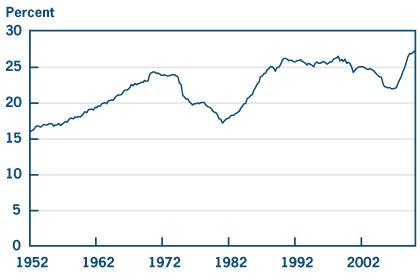
Note: Refers to the nonfarm nonfinancial corporate business sector.
Source: Federal Reserve Board.
Many economists have suggested that the weakness of corporate balance sheets is constraining business spending and investment, and that this in turn is impeding growth and the recovery. High levels of debt can depress spending and investment through several channels. Firms with high debt, for example, must devote more cash to interest payments, so they have less available for spending. The desire to repair their balance sheets may further discourage spending. Firms with weak balance sheets might also find it harder to obtain external funds for new investment projects. And when they can raise external funds, they must pay higher rates, which increases their cost of investing.
One particularly important investment-damping channel is one where the overhang of existing debt distorts firms’ incentives to invest, leading them to invest less than would be optimal if they had fewer liabilities. This Commentary explains this channel and the ways in which it could inhibit the budding recovery.
The Debt-Overhang Distortion
A debt-overhang problem arises when the burden of existing debt on a firm’s balance sheet grows so large that the firm faces a high risk of default. This, in turn, causes the market value of the debt to fall substantially short of its face value. When this happens, the debt overhang will distort the firm’s incentives to invest, causing it to pass up otherwise profitable investment opportunities.
The reason the firm will underinvest in this situation has to do with who makes investment decisions and who reaps the benefits of the investments. The equity holders decide whether to finance new investments, but they will have to split any increase in the firm’s value with the firm’s creditors, since the market value of the firm’s debt will increase as well. The greater the extent to which a new investment benefits the creditors rather than the equity holders, the less attractive that investment is to the equity holders.
From the viewpoint of the equity holders, the debt-overhang distortion acts like a tax on the increase in the firm’s value generated by new investment projects, and this may lead them to forego investment opportunities with positive net present value. (See box below.) In the end, financial risk—the risk that a firm will default—may lead it to underinvest.
How Debt Overhang Depresses Investment: An Example
Shareholders make investment decisions that will maximize their own benefit. They don’t figure benefits to the firm’s creditors into their decisions.
Will shareholders invest in project A?
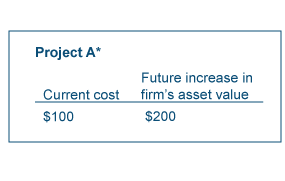
*Assume discount rate is zero, so project A has positive net present value.
Shareholders will invest only if the benefit from the project—the increase in equity—exceeds the cost of the project. The cost is $100, but the benefit depends on the condition of the firm’s balance sheet. Let’s see how the benefit changes in different scenarios.
Scenario 1: No debt overhang
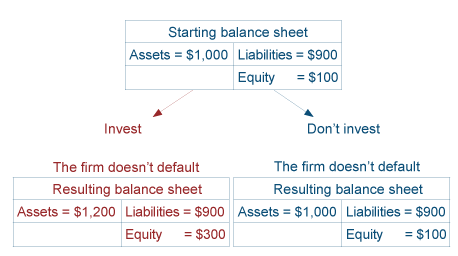
In this scenario, project A increases equity by $200. Since the cost is only $100, shareholders earn a $100 profit by investing. Therefore, they choose to invest, and there is no debt overhang distortion.
Scenario 2: Debt overhang
In this scenario an adverse balance sheet shock has lowered the value of assets relative to the first scenario.
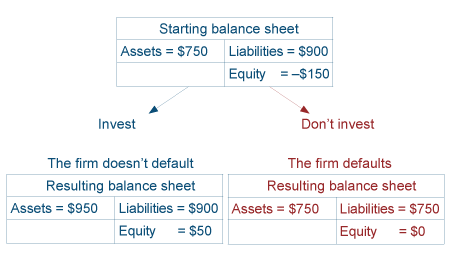
*Liabilities fall when firm defaults
In this scenario, project A increases equity by only $50. Since the cost is $100, shareholders lose $50 by investing. Therefore, they choose to not invest, and debt overhang distorts the investment decision. Although in this scenario the decision not to invest causes the firm to default, in more realistic cases, debt overhang makes firms underinvest, but does not necessarily lead them to default.
It’s not just existing debt overhang that could depress investment either. The chance of future debt overhang could curtail current investment as well. When a firm has the option of waiting to make investment decisions, the risk that it might face a future debt-overhang situation may lead it to postpone projects with positive net present values. This delay enables the firm to wait for the financial uncertainty to be resolved and to undertake the project only if there is no debt overhang. In this case, it is financial uncertainty—uncertainty about a firm’s future financial strength—that may lead it to underinvest.
Debt overhang also distorts the composition of firms’ investments, in terms of their riskiness. Although debt overhang depresses safe investments, it may actually encourage riskier projects. Everything else equal, the equity holders have an incentive to undertake risky projects because equity holders benefit from the upside of lucky outcomes, while the creditors bear the downside risks.
Nor is the impact of debt overhang limited to investment decisions. It also discourages other firm activities and decisions that imply a current cost and a future increase in the firm’s value, such as the work and effort exerted by managers and executives, hiring decisions, or expenditures incurred in order to maintain and improve production and sales. For instance, when a firm decides whether to hire, it weighs the current search, recruiting, and training costs against the future benefits offered by the additional productive worker. Just as debt overhang may lead firms to underinvest or to delay investing, it may lead them to restrain or delay hiring.
Some factors naturally mitigate the debt-overhang distortion. The desire to maintain a reputation or access to financial markets, for example, gives some firms an incentive to avoid default, which encourages investment. The sizeable costs of bankruptcy can have the same effect. Evidence suggests, however, that the impact of the distortion is large.
The Impact of Debt Overhang
Various studies have quantified the effect of debt overhang on investment. Among them, Hennessy, Levy, and Whited (2007) documented the importance of the debt-overhang distortion, especially for financially distressed firms. They find that debt overhang decreases the level of investment by approximately 1 to 2 percent for each percent increase in the leverage ratio of long-term debt to assets. This estimate for the debt-overhang impact is impressively large: it implies that a 10 percent decrease in assets, which is of the same order of magnitude as the one that occurred during the last financial crisis, would cause a 10 to 20 percent decrease in the investment level.
Occhino and Pescatori (2010) take a macroeconomic perspective and show that the debt-overhang distortion amplifies and propagates the effects of shocks to aggregate demand and supply. In addition to their standard contractionary effect, adverse macroeconomic shocks weaken firms’ balance sheets, increasing the debt-overhang distortion and diminishing firms’ incentives to invest. Because of this added effect, the impact of such shocks on the economy is much larger and more prolonged. For instance, the impact of a productivity shock on investment and production approximately doubles and extends for several years due to the propagation mechanism created by the debt-overhang distortion.
Given the large impact that the debt-overhang distortion has on firms’ investment, hiring, spending, and effort levels, debt overhang is likely to have been an important factor constraining the recovery. It is likely that it is still exerting a drag on hiring, investment, and growth.
How fast the impact will dissipate and investment levels will return to normal depends on how fast deleveraging will take place and how soon corporate balance sheets will be repaired. In cases where the overhang is not too severe, these improvements will occur through increased retained earnings, capital injections, and debt repayment. In worse cases, creditors may offer debt relief.
Debt Relief
The debt-overhang problem may be so severe that creditors can actually benefit from forgiving a portion of the debt. With excessively high levels of debt, the risk of default is large and the market value of debt is well below its face value. If the creditors forgive part of the debt in this situation, the lower debt burden helps realign the interests of the equity holders and the creditors. The firm’s effort and investment will rise, increasing the total value of the firm and the market value of the remaining debt. If this effect is strong enough, the market value of the remaining debt may be even higher than the market value of the total debt in the absence of debt forgiveness, in which case debt relief will ultimately benefit the creditors themselves.
Whether debt relief is ultimately in the interest of the creditors depends on the specific case of debt overhang. There are cases where the senior creditors are willing to forgive a portion of the debt, renegotiate it, or give up their seniority so the firm can obtain external funds by issuing additional secured debt. On occasion, there may be uncertainty and disagreement among the creditors themselves on whether debt relief is in their interest. When there are different classes of debt, the interests of creditors with different degrees of seniority may conflict. In addition, a free-rider problem may arise, as debt relief may not be in the interest of the creditors taken individually even if it benefits them as a group.
Although debt relief obviously alleviates the debt-overhang problem, it only represents a partial solution. Because the creditors offer debt relief only if they expect to benefit from it, the amount of debt they are willing to forgive is limited, and any debt remaining continues to distort the firm’s investment decisions.
A creditor takeover of the firm after it defaults is another potential solution to the debt-overhang problem. Creditors would have an incentive to undertake all profitable investment opportunities. However, this solution is not satisfactory either, since most investment opportunities depend on business continuity and disappear or lose substantial value when default occurs and the equity holders lose control of the firm.
Debt Relief
The second scenario in the box above provides an example in which offering debt relief would be in the interest of the creditors. Suppose the creditors forgave part of the debt, decreasing the face value from $900 to, say, $800. Shareholders would rather undertake Project A and avoid the firm’s default, a choice that would ultimately benefit the creditors as well.
Reducing the Risk of Debt Overhang
Some common borrowing practices and debt contract features have the effect of reducing, although not eliminating, the risk that firms will wind up with debt overhang. Shortening debt maturity is one example. The debt-overhang distortion is associated with debt that matures after investment decisions are made, that is, long-term debt. Issuing and rolling over short-term debt, for which the terms of the debt contracts can be modified depending on a firm’s condition, may reduce the likelihood of debt overhang.
The practice of matching the maturities of the firm’s assets and liabilities also reduces the likelihood of debt overhang. This is because the total value of a firm can be thought of as the sum of the value of the already installed assets plus the value of future investment opportunities. When the existing debt exceeds the value of the already installed assets, the difference needs to be repaid with the increase in the firm’s value generated by new investments. This means that part of the benefit of investing goes to the creditors, which is what creates the debt-overhang underinvestment problem. By matching the maturities of its assets and liabilities, the firm is effectively reducing the debt-overhang distortion.
The provision of a sinking fund, a separate account in which the firm deposits money at a predetermined schedule for the purpose of amortizing a loan over time, has an effect similar to matching maturities. The fund effectively decreases the level of the firm’s liabilities as the value of the already installed assets depreciates over time, so it also helps to reduce the likelihood of debt overhang.
Covenant restrictions in the debt contract also reduce the likelihood of a future debt-overhang problem. Such covenants are aimed at preserving the value of the senior debt. Some covenants are designed to preserve the value of the firm’s assets that can be seized by creditors, like covenants designed to preserve the liquidation value of collateral or to limit the ability of the firm to sell its assets. Other covenants protect the value of the senior debt by restricting the financing policy, maintaining the seniority, limiting leverage ratios, and constraining the capital structure. Other covenants restrict the firm’s distribution policy, limiting the cash payout through dividends and share repurchases.
For firms to face the proper incentive to reduce risks, however, it is important that creditors correctly assess, monitor, and price those risks. During the years that preceded the recent financial crisis, creditors became less concerned about leverage and risk. Those years were characterized by low risk premiums, relaxed lending standards, light-covenant agreements, and easy credit. With the benefit of hindsight, it might be argued that risk premiums remained excessively low and risk was mispriced, and that these factors helped cause the current situation of weak balance sheets and debt overhang.
Recommended Readings
- “Testing Q Theory with Financing Frictions,” by C.A. Hennessy, A. Levy, and T.M. Whited. 2007. Journal of Financial Economics, vol. 83, 691–717.
- “Determinants of Corporate Borrowing,” by S. C Myers. 1977. Journal of Financial Economics, vol. 5, 147–75.
- “Debt overhang and Credit Risk in a Business Cycle Model,” by F. Occhino and A. Pescatori. 2010. Federal Reserve Bank of Cleveland, working paper, no. 10-03.
- “An Overview of Covenants in Large Commercial Bank Loans,” J. K. Paglia. 2007. The RMA Journal.
This work by Federal Reserve Bank of Cleveland is licensed under Creative Commons Attribution-NonCommercial 4.0 International




